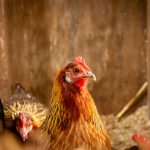Dogs possess a natural predatory instinct, rooted in their evolutionary history and reinforced through selective breeding for hunting and herding. This innate prey drive can pose a significant risk to smaller animals, including chickens. The instinct to chase and potentially harm prey is deeply ingrained in canine behavior, making it essential for dog owners to recognize and manage this trait when introducing dogs to chickens.
Dogs are also highly social creatures that form strong bonds with their human families. Their loyalty and protective nature can sometimes lead them to perceive chickens as potential threats to their territory or family unit. This protective instinct, while generally beneficial, can complicate the integration of chickens into a household with dogs.
Understanding these fundamental aspects of canine behavior is crucial for creating a safe and harmonious environment where both dogs and chickens can coexist. By acknowledging and addressing these natural instincts, owners can take proactive measures to ensure the safety of their chickens while maintaining a positive relationship with their dogs.
Table of Contents
Key Takeaways
- Dogs have natural instincts to chase and hunt small animals, including chickens
- A secure coop and run with strong fencing and a covered top is essential for keeping chickens safe from predators, including dogs
- Training dogs to be calm and gentle around chickens can help them coexist peacefully
- Supervision is crucial when dogs and chickens interact, especially during the initial introduction
- Using deterrents such as motion-activated sprinklers or citrus scents can help keep dogs away from chickens
- Providing separate spaces for dogs and chickens, such as separate fenced areas or designated indoor spaces, can prevent conflicts
- Seeking professional help from a dog trainer or behaviorist may be necessary if dogs show aggression towards chickens
Building a secure coop and run for chickens
Secure Coop and Run
One of the most crucial steps in keeping chickens safe when introducing them to dogs is to provide a secure coop and run. This involves building a sturdy enclosure that is predator-proof and equipped with strong fencing to keep dogs out. The coop should be elevated off the ground to prevent digging from predators, and the run should be covered with a secure roof to protect the chickens from aerial threats.
Providing Ample Space and Enrichment
In addition to a secure enclosure, it’s essential to provide the chickens with ample space to roam and forage while still being protected from potential harm. This can be achieved by creating a spacious run with plenty of room for the chickens to move around freely, as well as providing them with enriching activities such as perches, dust baths, and hiding spots.
Minimizing Conflict Risks
By creating a secure and comfortable environment for the chickens, owners can help minimize the risk of potential conflicts with dogs. By providing a safe and stimulating space for the chickens, owners can reduce the likelihood of stress and anxiety, which can contribute to conflicts with dogs.
Training dogs to coexist peacefully with chickens

Training plays a crucial role in helping dogs coexist peacefully with chickens. By teaching dogs basic obedience commands such as “sit,” “stay,” and “leave it,” owners can establish control over their dogs’ behavior and prevent them from chasing or harming the chickens. Positive reinforcement techniques, such as rewarding good behavior with treats or praise, can also be used to encourage dogs to remain calm and respectful around the chickens.
In addition to obedience training, desensitization exercises can be helpful in acclimating dogs to the presence of chickens. This involves gradually exposing dogs to the sight, sound, and smell of chickens in a controlled manner, while rewarding them for remaining calm and non-reactive. Over time, this can help dogs become more comfortable and less inclined to view the chickens as prey.
Supervising interactions between dogs and chickens
Even with training and precautions in place, it’s important for owners to closely supervise interactions between dogs and chickens, especially during the initial introduction phase. This can help prevent any potential conflicts or accidents from occurring, as well as allow owners to intervene if necessary. When supervising interactions, it’s important to observe the body language of both the dogs and the chickens.
Signs of tension or aggression, such as raised hackles, stiff posture, or predatory stalking behavior in dogs, should be addressed immediately by redirecting the dog’s attention or removing them from the situation. By staying vigilant and proactive, owners can help ensure the safety of both their dogs and chickens.
Using deterrents to keep dogs away from chickens
In some cases, it may be necessary to use deterrents to keep dogs away from chickens, especially if they continue to show a strong prey drive despite training efforts. This can include using physical barriers such as gates or fences to separate the dogs from the chicken coop and run, as well as using visual or auditory deterrents such as motion-activated alarms or sprinkler systems. Additionally, scent-based deterrents such as citrus peels or vinegar can be used to create an unpleasant barrier around the chicken coop that deters dogs from approaching.
By implementing these deterrents, owners can help reinforce boundaries and discourage unwanted behavior from their dogs.
Providing separate spaces for dogs and chickens

Separate Spaces for a Harmonious Coexistence
Providing separate areas for dogs and chickens within the home environment is crucial for their safety. This can be achieved by creating designated spaces for dogs to rest and play, which are separate from the chicken coop and run. Similarly, chickens should have secure housing that is inaccessible to dogs.
Establishing Clear Boundaries
By establishing clear boundaries and separate living spaces for both animals, owners can minimize potential conflicts and reduce the risk of accidents or injuries. This separation helps to prevent unwanted interactions between dogs and chickens, ensuring a safer environment for both.
Reducing Stress and Anxiety
Separate living spaces can also help alleviate any stress or anxiety that may arise from constant proximity between dogs and chickens. By giving each animal its own space, owners can promote a more relaxed and peaceful coexistence.
Seeking professional help if necessary
In some cases, despite best efforts, it may be necessary to seek professional help when introducing dogs to chickens. This can include consulting with a certified dog trainer or animal behaviorist who has experience working with multi-species households. These professionals can provide personalized guidance and training techniques tailored to the specific needs of both the dogs and the chickens.
Additionally, veterinarians can offer valuable insight into managing the relationship between dogs and chickens, as well as provide recommendations for ensuring the health and well-being of both animals. By seeking professional help when needed, owners can gain access to expert advice and support that can help facilitate a harmonious coexistence between their dogs and chickens. In conclusion, introducing dogs to chickens requires careful consideration of their natural instincts, as well as proactive measures to ensure their safety and well-being.
By understanding these instincts, providing secure housing for the chickens, training the dogs to coexist peacefully, supervising interactions, using deterrents when necessary, providing separate spaces, and seeking professional help if needed, owners can create a harmonious environment where both animals can thrive. With patience, consistency, and dedication, it is possible for dogs and chickens to coexist peacefully and enrich each other’s lives in a multi-species household.
If you’re looking for tips on how to keep your chickens safe from dogs, you might want to check out this article on The Chicken Coop Country Diner. It offers valuable insights on how to design a secure and predator-proof chicken coop to protect your flock from potential threats.
FAQs
What are some ways to keep chickens safe from dogs?
Some ways to keep chickens safe from dogs include building a secure coop and run, using fencing and hardware cloth, and training dogs to coexist peacefully with the chickens.
How can I build a secure coop and run for my chickens?
To build a secure coop and run for your chickens, use sturdy materials such as wood and hardware cloth, ensure that the coop has a secure door, and provide a roof to protect the chickens from aerial predators.
What type of fencing should I use to keep dogs away from my chickens?
To keep dogs away from your chickens, use fencing that is at least 6 feet high and buried at least 12 inches into the ground to prevent digging. Additionally, consider using electric fencing as an added deterrent.
How can I train my dog to coexist peacefully with my chickens?
To train your dog to coexist peacefully with your chickens, start by introducing them to the chickens while on a leash and using positive reinforcement. Gradually increase their exposure to the chickens while closely supervising their interactions.
Meet Walter, the feathered-friend fanatic of Florida! Nestled in the sunshine state, Walter struts through life with his feathered companions, clucking his way to happiness. With a coop that’s fancier than a five-star hotel, he’s the Don Juan of the chicken world. When he’s not teaching his hens to do the cha-cha, you’ll find him in a heated debate with his prized rooster, Sir Clucks-a-Lot. Walter’s poultry passion is no yolk; he’s the sunny-side-up guy you never knew you needed in your flock of friends!







